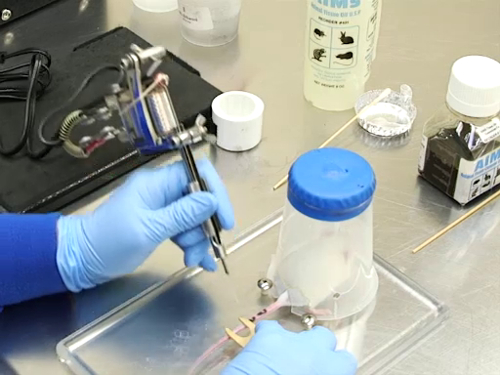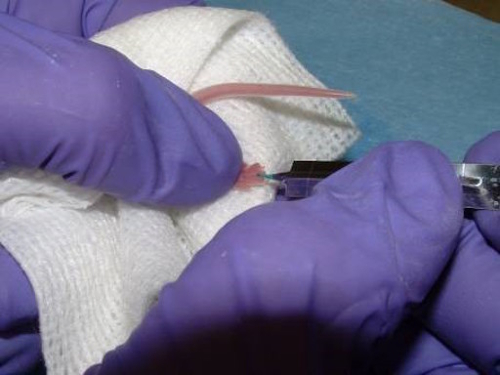1. Tatuaggio della coda
I tatuaggi della coda sono facilmente leggibili senza la necessità di maneggiare l'animale.

Figura 1. Tatuaggio della coda su topi adulti
- Preparare l'attrezzatura per tatuaggi secondo le istruzioni del produttore. È necessaria una piccola quantità di inchiostro. Il colorante nero dovrebbe essere usato per topi albini o ratti e il colorante verde per topi o ratti pigmentati.
- Preparare gli animali per l'identificazione.
NOTA: per ridurre al minimo l'apprensione o l'angoscia, il tatuaggio della coda deve essere eseguito in una sala procedure piuttosto che in un'area di stabulazione degli animali.
- Trattenere in modo appropriato l'animale per il tatuaggio in modo che il movimento sia minimo.
- I ratti svezzati sono trattenuti usando una tazza di plastica dentellata, con il labbro della tazza fissato sotto i bulloni sulla piattaforma del tatuaggio e la coda che si estende attraverso la tacca.
- I topi adulti possono essere trattenuti per mezzo di un limitatore a tazza, con la coda tirata tesa dall'apertura e la flangia della tazza tenuta in posizione tramite una piattaforma o un altro dispositivo.
- Pulire la coda con una piccola quantità di detergente per tessuti diluito applicato con un tampone con punta di cotone. I ratti adulti hanno generalmente un accumulo di squame e detriti sulla coda che devono essere puliti prima di applicare il tatuaggio. Uno scrub di acqua e sapone della coda rimuoverà la maggior parte dello sporco e dei detriti. Asciugare bene la coda prima di procedere.
- Applicare l'olio di tessuto sulla pelle con un tampone con punta di cotone appena prima del tatuaggio. L'olio di tessuto è necessario per ridurre al minimo il danno tissutale ammorbidendo la pelle e lubrificando l'ago del tatuaggio. Inoltre, l'olio scioglie lo sporco non rimosso dal processo di pulizia e previene la colorazione dell'inchiostro della pelle non macchiata.
- Applicare il tatuaggio.
- Immergere la punta dell'ago nel pigmento con la macchina spenta.
- Porta la punta dell'ago al sito del tatuaggio con la pistola attivata dal pedale.
- Fai tratti brevi e pari in una direzione. Numeri e lettere dovrebbero essere tatuati in modo tale da essere costruiti in segmenti con angoli e curve minimi (quando possibile).
- Penetrare abbastanza profondamente nel derma con l'ago per la deposizione permanente di pigmento. Un cambiamento nel suono dell'ago attivato può aiutare a discernere la profondità.
- Avvicinarsi alla pelle con l'ago con un angolo di 90o per un'adeguata deposizione di pigmento.
- Pulizia e cura post-tatuaggio
- Macchia (non pulire) il tatuaggio completato del pigmento in eccesso con un asciugamano di carta.
- La presenza di sangue sul tatuaggio o sul tovagliolo di carta indica che il tatuaggio è stato fatto troppo in profondità ed è quindi improbabile che sia permanente.
- Rinforza le aree sottili dei personaggi del tatuaggio con pigmento aggiuntivo. I personaggi sono rinforzati con pigmento depositato parallelamente, ma non sopra, pigmento già depositato.
- Per aggiungere ulteriore pigmento, immergere la punta dell'ago nel serbatoio del colorante per ogni due caratteri per i topi e ogni carattere per i ratti.
- Le ragioni per i tatuaggi sbiaditi includono quantità inadeguate di pigmento, tatuaggi fatti troppo superficiali, tatuaggi fatti troppo profondamente, un angolo inappropriato dell'ago sulla pelle, aghi smussati o uncinati utilizzati o il tatuaggio fatto troppo rapidamente.
- Pulire accuratamente l'attrezzatura del tatuaggio dopo ogni utilizzo secondo le istruzioni del produttore.
2. Tatuaggio delle dita dei neonati
I protocolli sperimentali possono richiedere la genotipizzazione dei neonati già dal primo giorno, il che rende essenziale che questi cuccioli siano identificati in modo permanente. L'uso del tatuaggio delle dita dei dita dei dita consente di identificare gli animali fino a quando non sono abbastanza grandi per l'etichettatura auricolare o la punzonatura dell'orecchio.

Figura 2. La corretta tecnica di contenimento per tatuare un topo neonato. La lancetta ha la tintura verde sulla punta.
- Trattenere i cuccioli pre svezzati.
- Coppetta il neonato in mano su un tampone di garza. Posiziona il piede tra il pollice e la curva dell'indice per esporre la punta o le dita dei piedi scelte per il tatuaggio.
- Tieni il piede vicino alle dita dei piedi in modo che la dita abbia una superficie solida dietro di essa, impedendole di piegarsi.
- Non sovrareti la gamba quando si posiziona il piede. I cuccioli che sono trattenuti possono muoversi, ma non si sente necessariamente alcuna vocalizzazione.
- Preparare l'attrezzatura.
- Selezionare una lancetta animale Goldenrod da 4,5 mm.
- Posiziona una piccola macchia di pasta verde per tatuaggi su una superficie non porosa; il foglio di alluminio funziona bene.
- Immergere solo la punta della lancetta nella pasta del tatuaggio.
- Usa solo una piccola quantità di pasta.
- Applicare il tatuaggio.
- Colpisci la punta desiderata con la lancetta Goldenrod secondo un codice identificativo.
- Perforare la pelle per introdurre la pasta nella pelle, lasciando un segno.
- Colpisci lo stesso punto tre volte per assicurare una corretta penetrazione.
- Evita di colpire così profondamente che la punta sanguina; questo può provocare un tatuaggio più debole.
- Pulizia e cura post-tatuaggio
- Asciugare delicatamente il punto con una salvietta/ asciugamano assorbente per rimuovere la pasta in eccesso.
- Non tentare di pulire la pasta in eccesso dal piede o dal corpo.
- Riporta l'animale nella sua gabbia.
- Quando i cuccioli che allattano sono tatuati, è consigliabile tatuare anche la diga. Ciò potrebbe impedirle di reazioni eccessive alla pasta sui cuccioli, il che potrebbe portare a un'eccessiva cura del tatuaggio.
- Usa una nuova lancetta per ogni cucciolata.
- I tatuaggi devono essere verificati il giorno dopo la procedura. Rifare il tatuaggio se i punti sono deboli o non visibili. Se i punti sono visibili il giorno dopo il tatuaggio, dovrebbero rimanere visibili per tutta la vita dell'animale.
3. Tatuaggio delle dita dei dito dei dito di ratti e topi adulti
Quando una cucciolata di neonati viene tatuata, si suggerisce che anche la madre sia tatuata in modo che la pasta sui suoi cuccioli non le sia estranea.
- Contenimento dell'animale.
- Trattenere l'animale usando un cono di plastica o un freno in plexiglass che consente l'accesso ai piedi posteriori.
- Estendere il piede dal dispositivo di ritenuta.
- Posizionare il piede tra il pollice e la curva dell'indice per esporre la punta o le dita dei piedi scelte per il tatuaggio
- Tenere il piede vicino alle dita dei piedi in modo che la dita abbia una superficie solida dietro di esso, impedendo alla dito di piegarsi.
- Non sovrareti la gamba quando si posiziona il piede. Gli adulti che sono trattenuti possono cercare di ritirare il piede.
- Preparare l'attrezzatura.
- Selezionare una lancetta animale Goldenrod da 5 mm.
- Posiziona una piccola macchia di pasta verde per tatuaggi su una superficie non porosa; il foglio di alluminio funziona bene.
- Immergere solo la punta della lancetta nella pasta del tatuaggio.
- Usa solo una piccola quantità di pasta.
- Applicare il tatuaggio.
- Colpisci la punta desiderata con la lancetta Goldenrod secondo un codice identificativo.
- Perforare la pelle per introdurre la pasta nella pelle, lasciando un segno.
- Colpisci lo stesso punto tre volte per assicurare una corretta penetrazione.
- Evita di colpire così profondamente che la punta sanguina; questo può provocare un tatuaggio più debole.
- Pulizia e cura post-tatuaggio
- Asciugare delicatamente il punto su una salvietta / asciugamano assorbente per rimuovere la pasta in eccesso.
- Non tentare di pulire la pasta in eccesso dal piede o dal corpo.
- Riporta l'animale nella sua gabbia.
- Usa una nuova lancetta per ogni animale.
- I tatuaggi devono essere verificati il giorno dopo la procedura. Rifare il tatuaggio se i punti sono deboli o non visibili. Se i punti sono visibili il giorno dopo il tatuaggio, dovrebbero rimanere visibili per tutta la vita dell'animale.
4. Microchip
L'impianto di un chip RFID è un metodo comunemente usato per identificare gli animali.
- Caricare il microchip nell'applier o selezionare una siringa precaricata.
- Trattenere l'animale utilizzando un tubo di ritenuta in plexiglass che consente di afferrare la pelle sopra le spalle.
- Tenda la pelle, creando una tasca.
- Posizionare l'ago attraverso la pelle, smussare verso l'alto e parallelamente alla colonna vertebrale e indirizzarlo verso la coda.
- Espellere il microchip per via sottocutanea.
- Prelevare l'ago e pizzicare la pelle chiusa nel punto di iniezione. Ciò impedisce al microchip di seguire l'ago fuori dalla pelle. Continuare ad applicare pressione per fornire emostasi per qualsiasi sanguinamento della pelle.
- Rimuovere l'animale dal dispositivo di ritenuta e scansionare il chip per confermare il codice di identificazione.

Figura 3. Posizionamento di microchip in ratti adulti.
5. Identificazione temporanea per topi
Coloranti non tossici e marcatori animali possono essere utilizzati per l'identificazione temporanea dei topi.
- Trattenere il mouse in modo tale che l'area tra le scapole sia accessibile per i segni sulla pelliccia.
- Posiziona un pennarello, una macchia o una striscia di colorante sulla pelliccia in quest'area. Questa regione viene utilizzata per impedire all'animale di rimuovere la marcatura durante la toelettatura.
- Controllare periodicamente la marcatura se lo si utilizza come unico identificatore per più di qualche giorno.
- La coda può essere utilizzata anche per brevi durate. Tuttavia, l'animale può rimuovere un segno da esso durante la toelettatura.
6. Identificazione temporanea per i ratti
- Trattenere il ratto in modo che l'area per l'applicazione di coloranti o marcatori sia facilmente accessibile. In alcuni casi, quando è necessaria solo una striscia o un punto, l'animale non avrà bisogno di essere trattenuto ma è autorizzato a muoversi liberamente nella gabbia.
- Il contenimento manuale afferrando la coda e tenendola tesa durante l'applicazione dell'identificazione è comunemente fatto.
- L'immobilizzazione temporanea con anestetici inalanti può essere eseguita per animali litigiosi.
- Controllare periodicamente la marcatura se si utilizza questo metodo come unico identificatore per più di qualche giorno.

















